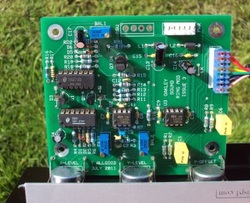Ring Mod Demo from Atomic Shadow on Vimeo.
Having spent several hours feeding various things in to this module I have to say that I really love it. Ring modulation is a hallmark of Atomic Shadow and this is by far my favorite one of all time. Lets take a look at what the Krisp website has to say about this module...

A ring modulator has two main inputs, usually called X and Y, and one output. The output voltage is the product of the two input voltages. In other words it multiplies the two input signals together to produce a new and different sounding output. If you have two sine wave input signals then the output will have both the sum and difference frequencies. For example, if X is a 440Hz sinewave and Y a 40Hz, you would get a 480Hz and a 400Hz sinewave from the output. However, this is only really true in a perfect ring modulator... And this ring modulator is not that. Each input has its own differing non-linearities or imperfections. This greatly adds to the character of the resultant output.
The Oakley Ring Modulator features three rotary control pots. Each input has its own attenuator, and there's also a offset control for the Y input. In conjunction with the Y attenuator, this third pot effectively acts as a wet-dry control for the X input. But because of the non-linearities inherent in the design it also acts in more subtle ways.
You can also use the Oakley Ring Mod as a standard VCA. Just use the Y input as your CV input and X will be shaped accordingly.
Each input can be either direct coupled (DC) or high pass filtered (AC). The former allows DC and low frequency signals to be processed. While the latter provides a DC block to process only alternating frequencies."
Character, differing non-linearities, and imperfections? Check. All present and accounted for.
I found that by turning the input levels up can create some interesting moaning and buzzing drones. Part way through the video I brought in the Strymon tape echo pedal. Sine waves, ring modulation and tape echo are the holy trinity as far as I am concerned. These three elements have a synergy.

They make a nice selection of DotCom compatible modules with some interesting design features. If you own a DotCom system and have been thinking about expanding (let's be honest, you are. you tell your wife something else, but we all know that you are lying) take a look at the video and visit the Krisp1 Modular Construction link.
http://krisp1.com/store/

 RSS Feed
RSS Feed
